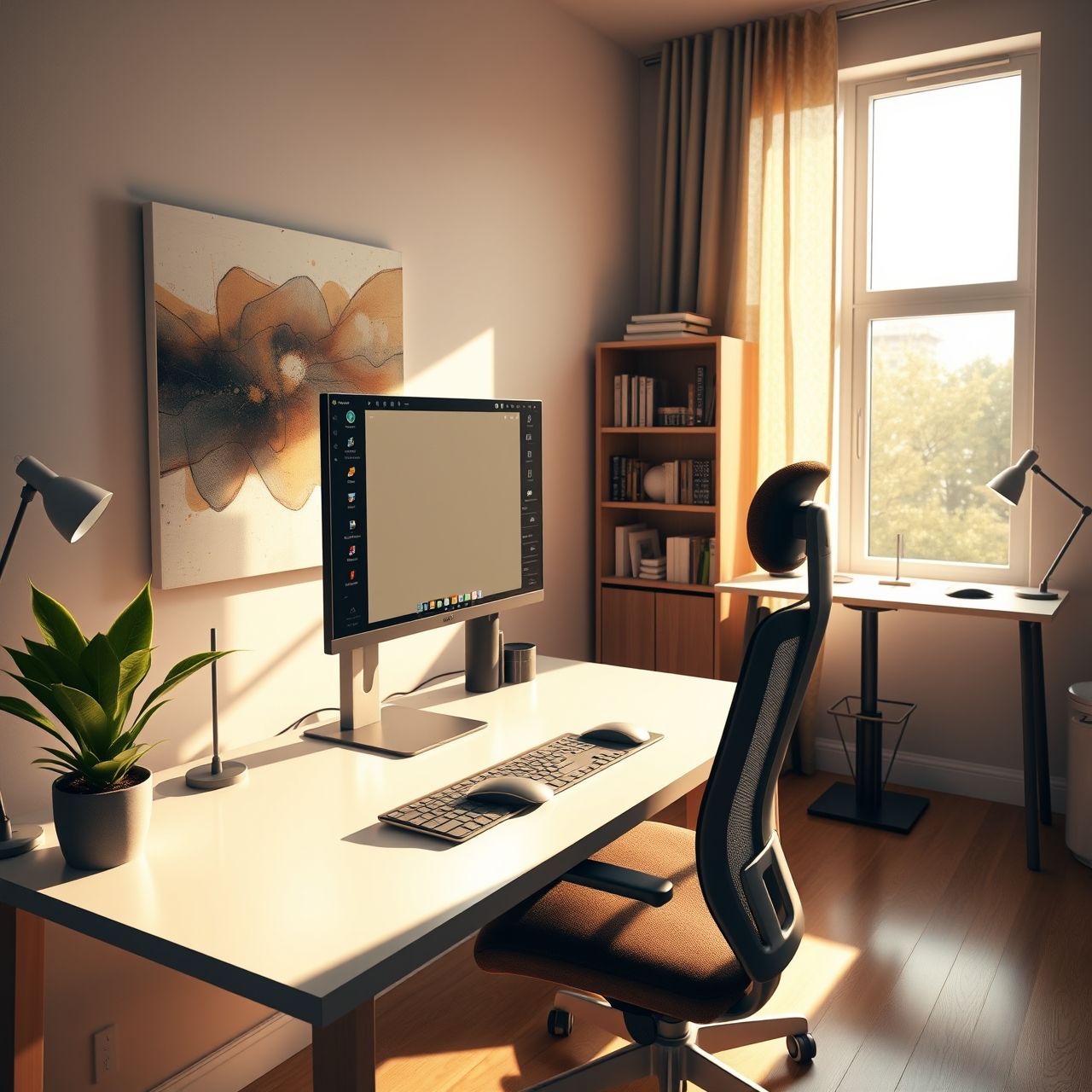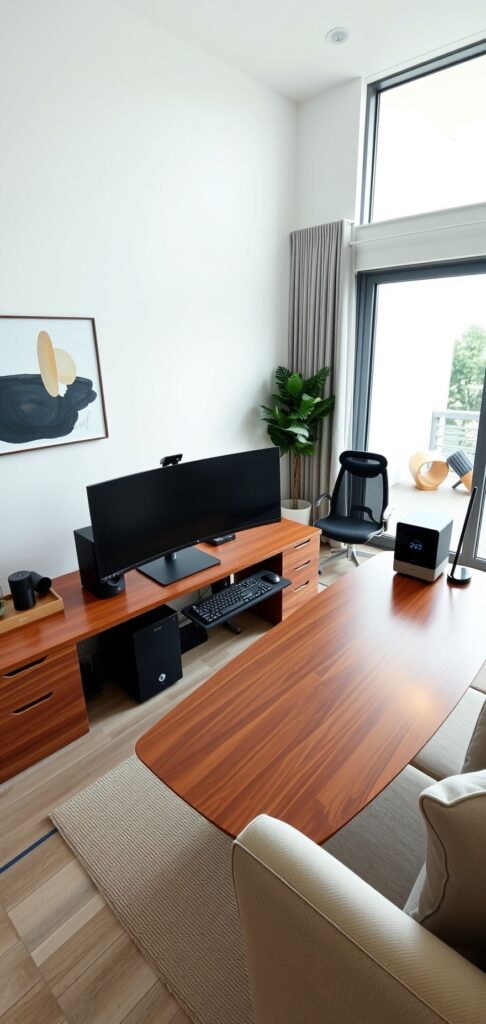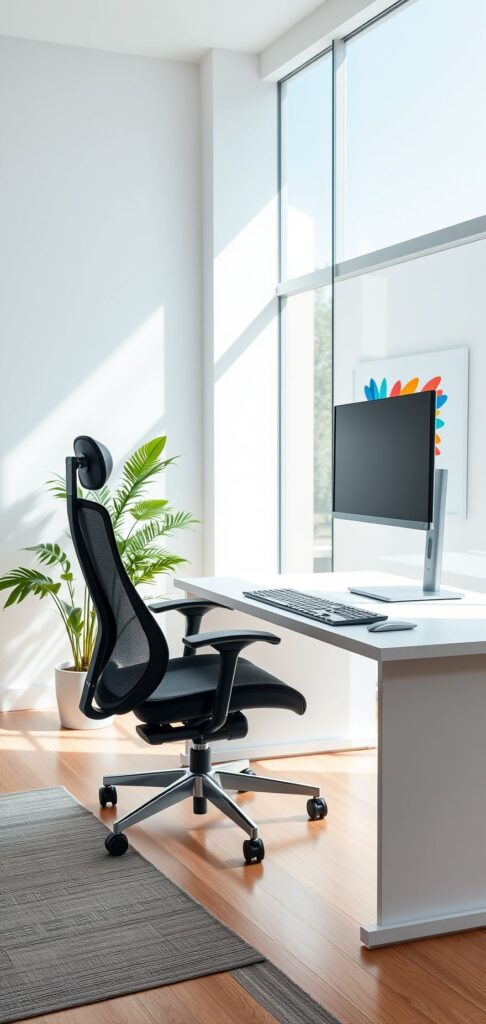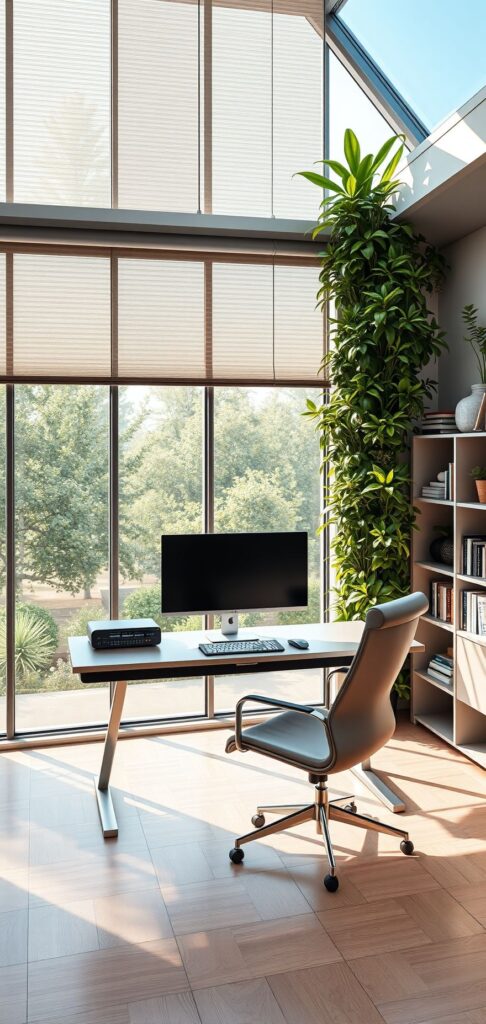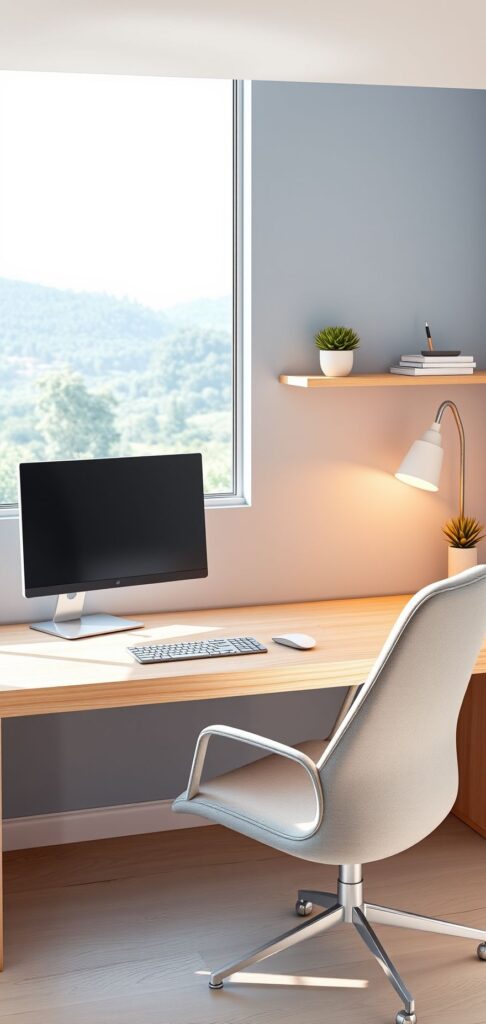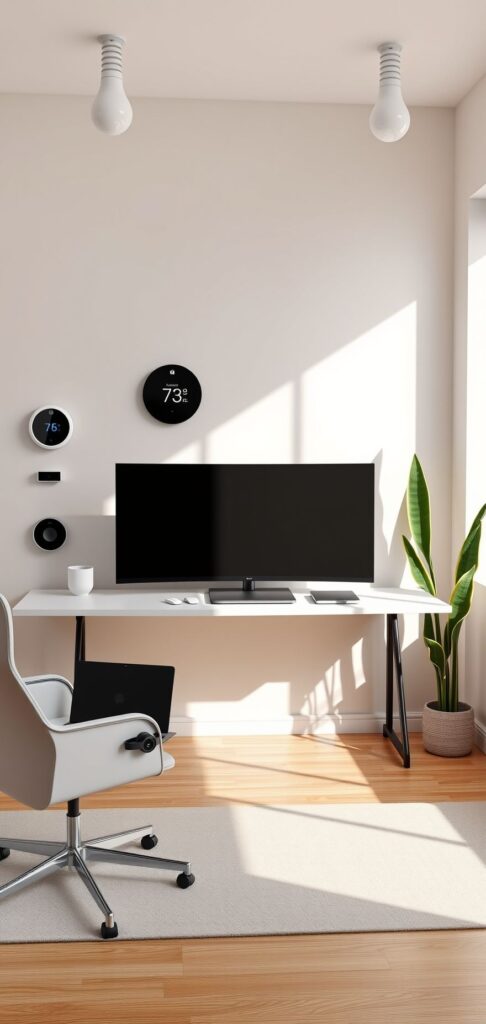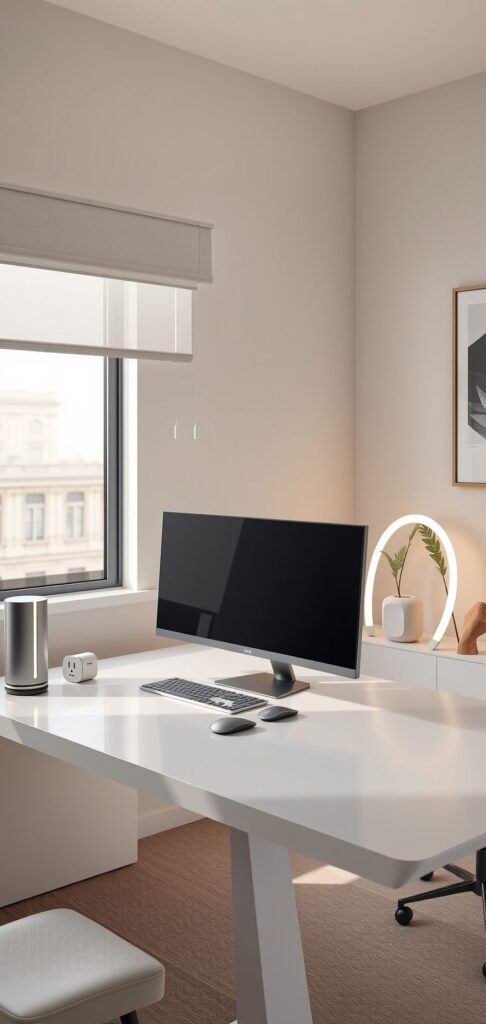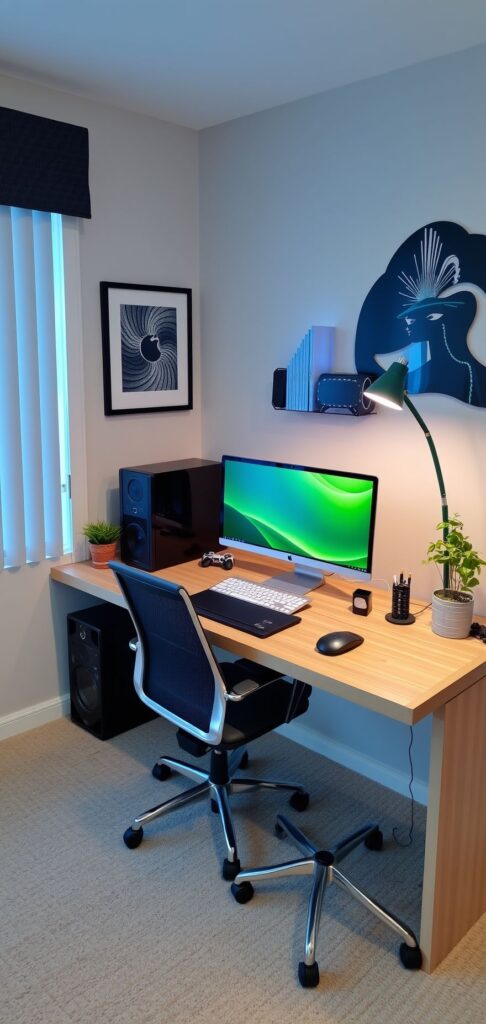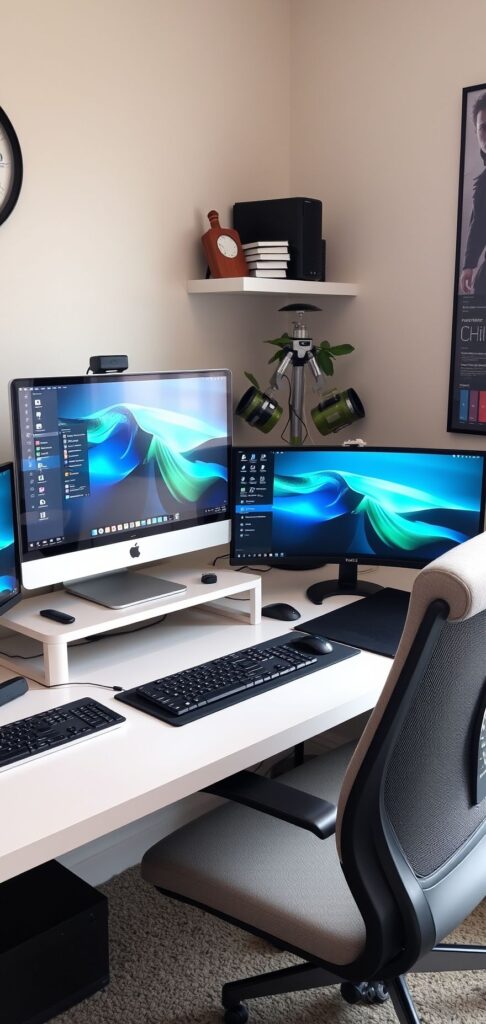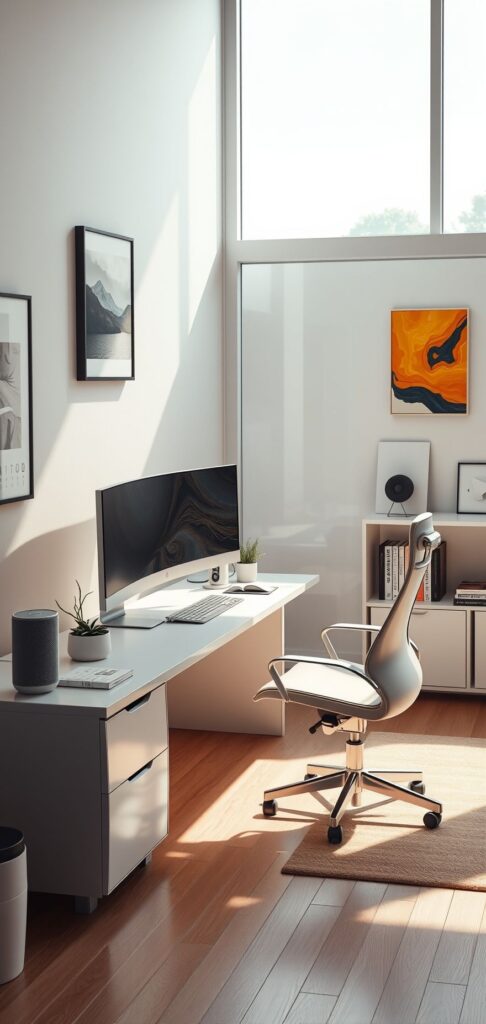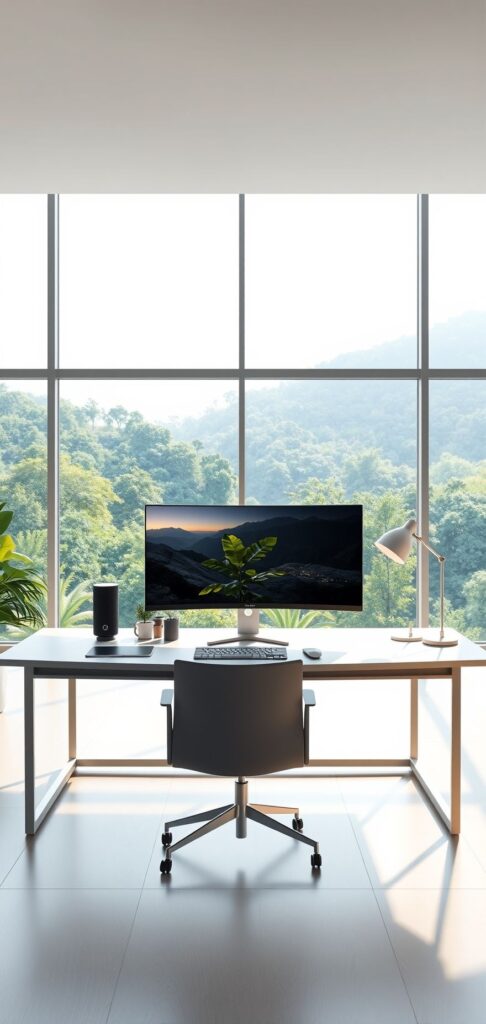Key Takeaways
- Setting up a comfortable home office isn’t just about getting your computer to work; its about creating a space that enhances productivity, comfort, and overall well-being.
- Optimize your desk setup for comfort: Position your monitor at eye level and ensure your keyboard and mouse are within easy reach to avoid strain. Invest in a supportive chair that promotes good posture and consider an ergonomic keyboard for added comfort.
- Harness natural light to boost mood and productivity: Position your desk near a window to benefit from natural light, which can improve your mood and reduce eye strain. Use curtains or blinds to control the amount of light and minimize glare on your screen.
- Create a minimalist workspace for clarity: A clutter-free desk can help reduce distractions and enhance focus. Use cable organizers to keep wires tidy, and choose a simple, clean design for your desk and accessories.
- Set up a reliable internet connection: Ensure you have a stable and fast Wi-Fi connection to support your work tasks. Consider using a wired connection for a more consistent and secure experience.
- Secure your new PC against threats: Install a reliable antivirus and firewall, and set up strong, unique passwords for all your accounts. Regularly update your software and operating system to protect against the latest threats.
- Customize your PC for a personalized experience: Adjust your desktop settings to suit your preferences, such as changing the wallpaper, organizing your files, and setting up essential apps. Use Windows 10/11 features like virtual desktops to manage multiple tasks efficiently.
- Optimize your PC for better performance: Disable unnecessary startup programs, perform regular disk cleanups, and defragment your hard drive to keep your PC running smoothly. Consider upgrading to an SSD for faster boot times and improved overall performance.
- Add personal touches to your space: Decorate your home office with plants, artwork, or personal items to make it a welcoming and enjoyable environment. A few personal touches can go a long way in boosting your motivation and creativity.
- Prioritize your well-being with regular breaks: Set reminders to take short breaks to stretch, move around, and rest your eyes. This can help prevent fatigue and keep you more productive throughout the day.
By focusing on both the technical and aesthetic aspects of your home office setup, you can create a space that not only supports your work but also enhances your overall quality of life. In the following sections, well dive deeper into each of these tips to help you set up a comfortable and efficient home office.
Imagine transforming your home office into a sanctuary where productivity and comfort go hand in hand. Setting up a comfortable and functional home office isnt just about getting your computer to work; its about creating a space that enhances your well-being and maximizes your efficiency. From ergonomic setups to personalized touches, the right computer setup can make a world of difference in your daily routine.
Lets dive into essential tips for setting up a comfortable home office that not only supports your work but also elevates your overall quality of life. Whether youre a beginner or a tech-savvy professional, these insights will help you create a functional and aesthetically pleasing workspace that promotes productivity and well-being.
Step-by-Step Setup of a New Computer
Basic Computer Setup for Beginners
Setting up a new computer can be an exciting but daunting task, especially for beginners. Heres a simple guide to get you started:
- Unbox Your New Computer: Carefully remove your new computer from the box and identify all the components, including the monitor, keyboard, mouse, and any additional peripherals.
- Connect the Power Cable: Plug the power cable into your computer and ensure it is securely connected to a power outlet.
- Connect the Monitor: Attach the monitor to the computer using the appropriate cable (HDMI, DisplayPort, or VGA). If you have a dual-monitor setup, connect both monitors.
- Connect the Keyboard and Mouse: Plug the USB cables of your keyboard and mouse into the available USB ports on your computer.
- Turn On Your Computer: Press the power button to turn on your computer. Follow the initial setup prompts, which may include language selection, time zone, and network setup.
Essential Steps to Set Up a New PC
Once your computer is up and running, there are a few essential steps to ensure a smooth and secure experience:
- Create a New User Account: Set up a new user account and choose a strong, unique password to protect your data.
- Connect to Wi-Fi or Ethernet: Connect to your Wi-Fi network by selecting it from the list of available networks. Alternatively, use an Ethernet cable for a more stable and secure connection.
- Install Essential Software and Drivers: Download and install necessary software and drivers for your computer. This includes operating system updates, antivirus software, and any specific drivers for your hardware.
Optimize Your Desk Setup for Comfort
Position Your Monitor at Eye Level
A properly positioned monitor can significantly reduce eye strain and neck pain:
- Height Adjustment: Ensure your monitor is at a height where the top of the screen is at or slightly below eye level. This helps maintain a natural head position.
- Monitor Stand or Arm: If your monitor is too low or high, consider using a monitor stand or an adjustable arm to achieve the ideal height.
Keyboard and Mouse Placement
The placement of your keyboard and mouse can greatly affect your comfort and productivity:
- Ergonomic Positioning: Place your keyboard and mouse within easy reach to avoid reaching or straining. Your wrists should be in a neutral position, not bent up or down.
- Ergonomic Options: Consider using an ergonomic keyboard and mouse, which are designed to reduce strain and improve comfort.
Invest in a Supportive Chair
A good chair is essential for maintaining good posture and preventing back pain:
- Posture Support: Choose a chair that promotes good posture and provides lumbar support. Look for features like adjustable height, armrests, and tilt.
- Comfort and Adjustability: Adjust the height and tilt of your chair to ensure your feet are flat on the floor and your knees are at a 90-degree angle.
Harness Natural Light to Boost Mood and Productivity
Position Your Desk Near a Window
Natural light can have a significant impact on your mood and productivity:
- Optimal Placement: Place your desk near a window to benefit from natural light. This can help reduce eye strain and improve your overall well-being.
- Control Glare: Use curtains or blinds to control the amount of light and minimize glare on your screen.
Enhance Workspace Lighting
Supplement natural light with additional lighting to create a comfortable environment:
- Desk Lamp: Add a desk lamp with a warm, soft light to reduce eye strain. Position it to avoid casting shadows on your work area.
- Indirect Lighting: Use indirect lighting, such as floor lamps or ceiling lights, to create a more inviting and comfortable atmosphere.
Create a Minimalist Workspace for Clarity
Keep Your Desk Clutter-Free
A clean and organized desk can help you stay focused and productive:
- Cable Management: Use cable organizers to keep wires tidy and reduce visual clutter. This can also help prevent accidents.
- Simple Design: Choose a simple, clean design for your desk and accessories. Avoid overcrowding your workspace with unnecessary items.
Organize Your Digital Space
Keeping your digital space organized is just as important as your physical space:
- Cable Management System: Use a cable management system to keep your cables organized and out of sight.
- Regular File Cleanups: Regularly clean up your desktop and organize your files into folders. Create shortcuts for frequently used files and applications.
Set Up a Reliable Internet Connection
Choose a Stable Wi-Fi Connection
A reliable internet connection is crucial for a smooth and efficient work experience:
- Secure and Fast Wi-Fi: Ensure you have a secure and fast Wi-Fi connection. Check your network settings to ensure you are connected to the correct network.
- Minimize Interference: Position your router to minimize interference from other devices and maximize signal strength.
Consider a Wired Connection
For a more consistent and secure internet experience, consider using a wired connection:
- Ethernet Cable: Use an Ethernet cable to connect your computer directly to your router. This can provide a more stable and faster connection.
- Test Connection Speed: Test your connection speed to ensure it meets your work requirements. Use online tools to measure your download and upload speeds.
Secure Your New PC Against Threats
Install Reliable Antivirus and Firewall
Protecting your PC from threats is essential for maintaining the security of your data:
- Reputable Antivirus and Firewall: Choose a reputable antivirus and firewall to protect your PC. Popular options include Norton, McAfee, and Windows Defender.
- Automatic Updates: Set up automatic updates to keep your security software current and protect against the latest threats.
Set Strong, Unique Passwords
Using strong, unique passwords is a critical step in securing your PC:
- Password Manager: Use a password manager to generate and store strong passwords. This can help you manage multiple accounts without the risk of forgetting or reusing passwords.
- Multi-Factor Authentication: Enable multi-factor authentication (MFA) for added security. This adds an extra layer of protection by requiring a second form of verification.
Customize Your PC for a Personalized Experience
Adjust Desktop Settings
Personalizing your desktop can make your workspace more enjoyable and functional:
- Desktop Wallpaper: Change your desktop wallpaper to reflect your personal style. Choose images that inspire you and make your workspace more inviting.
- Organize Files and Shortcuts: Keep your files organized and create useful shortcuts for quick access. This can help you stay productive and reduce clutter.
Use Windows 10/11 Features
Windows 10 and 11 offer several features to enhance your user experience:
- Virtual Desktops: Explore virtual desktops to manage multiple tasks efficiently. You can switch between different desktops to keep your work organized.
- Taskbar and Start Menu: Customize your taskbar and start menu for a more intuitive experience. Add or remove items to suit your needs.
Optimize Your PC for Better Performance
Disable Unnecessary Startup Programs
Disabling unnecessary startup programs can improve your PCs performance:
- Task Manager: Use the Task Manager to identify and disable programs that run on startup. This can help reduce boot times and improve overall performance.
- Lean System: Keep your system lean by removing unnecessary programs and services.
Perform Regular Disk Cleanups
Regular disk cleanups can help free up space and optimize your PCs performance:
- Disk Cleanup Tools: Use disk cleanup tools to remove temporary files, system files, and other unnecessary data. This can help free up space and improve system speed.
- Defragmentation: Defragment your hard drive to optimize data access. Note that this is not necessary for SSDs, as they do not benefit from defragmentation.
Consider Upgrading to an SSD
Upgrading to a solid-state drive (SSD) can significantly improve your PCs performance:
- Faster Boot Times: Replace your hard drive with an SSD for faster boot times and improved overall performance.
- Data Transfer: Transfer your data and reinstall essential software on the new drive to ensure a smooth transition.
Add Personal Touches to Your Space
Decorate with Plants and Artwork
Adding personal touches can make your workspace more inviting and enjoyable:
- Greenery: Add small plants to your desk to improve air quality and mood. Plants like succulents, spider plants, and peace lilies are low-maintenance and easy to care for.
- Artwork: Hang artwork or posters that inspire you and make your space more inviting. Choose pieces that reflect your personality and interests.
Incorporate Personal Items
Displaying personal items can make your workspace more cozy and welcoming:
- Photos and Mementos: Display personal items like photos, mementos, or decorative objects. These can help create a comfortable and inviting environment that reflects your personality.
Prioritize Your Well-Being with Regular Breaks
Set Reminders for Breaks
Taking regular breaks is essential for maintaining your well-being and productivity:
- Timers and Apps: Use a timer or app to remind you to take short breaks throughout the day. This can help you avoid fatigue and eye strain.
- Stand Up and Move: Stand up, stretch, and move around to reduce fatigue and improve circulation.
Stretch and Exercise
Incorporating simple stretches and exercises into your break routine can help reduce muscle tension and improve your overall well-being:
- Basic Stretches: Try basic stretches like neck rolls, shoulder shrugs, and wrist extensions. These can help relieve tension and improve flexibility.
- Standing Desk: Consider using a standing desk or alternating seating options to change your position and reduce strain.
Rest Your Eyes
Prolonged screen time can lead to eye strain and fatigue. Follow these tips to rest your eyes:
- 20-20-20 Rule: Every 20 minutes, look at something 20 feet away for 20 seconds. This can help reduce eye strain and improve focus.
- Blue Light Filters: Use blue light filters or glasses to reduce the impact of blue light on your eyes. This can help you stay comfortable and productive during long work sessions.
Setting up a new computer and optimizing your workspace involves a combination of technical steps and personal touches to create a comfortable, efficient, and secure environment. By following the basic setup steps, such as connecting peripherals, creating a user account, and installing essential software, you can ensure your computer is ready for use. Enhancing your physical workspace with ergonomic adjustments, natural light, and a minimalist design can significantly boost your comfort and productivity. Additionally, securing your PC with reliable antivirus software and strong passwords is crucial for protecting your data. Regular maintenance, including disabling unnecessary startup programs and performing disk cleanups, will keep your system running smoothly. Finally, personalizing your space with plants, artwork, and personal items, and prioritizing your well-being with regular breaks, will make your workspace more inviting and enjoyable. By following these guidelines, you can create a setup that supports both your professional tasks and your personal well-being.

